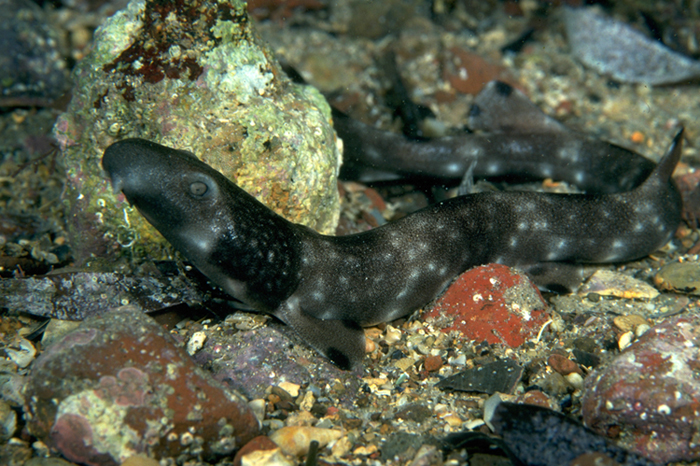Varied Carpetshark, Parascyllium variolatum (Duméril 1853)
Other Names: Necklace Carpet Shark, Necklace Carpetshark, Ring-necked Catshark, Southern Catshark, Varied Carpet Shark, Varied Catshark

A Varied Carpetshark, Parascyllium variolatum, in Port Phillip, Victoria. Source: Rudie H. Kuiter / Aquatic Photographics. License: All rights reserved
Summary:
A slender eel-like shark with a greyish to brownish body, a distinctive broad black collar behind the head speckled with small white spots, indistinct dark saddles and pale spots along the body, and large dark blotches on the fin margins. These small nocturnal sharks are rarely seen during daylight hours.
Cite this page as:
Bray, D.J. 2025, Parascyllium variolatum in Fishes of Australia, accessed 02 Jul 2025, https://fishesofaustralia.net.au/Home/species/1977
Varied Carpetshark, Parascyllium variolatum (Duméril 1853)
More Info
|
Distribution |
Endemic to southern Australia, from off Wilsons Promontory, Victoria, to Dongara, Western Australia, including the Bass Strait islands and southern Tasmania. Although relatively common, the Varied Carpetshark shelters in caves, crevices and under ledges during the day, foraging at night amongst kelp, seagrass beds and over sandy areas. |
|
Features |
Jaw teeth (upper) 28; Jaw teeth (lower) 32. Body very long and slender, almost eel-like, with a rounded head, a small underslung mouth and short fleshy nasal barbels; two dorsal fins of similar size, well back on the body, the first arising between the pelvic and anal fins. |
|
Colour |
Greyish to brownish with indistinct dark saddles and pale spots on body; a distinctive broad black collar speckled with small white spots behind head. |
|
Feeding |
Feeds mostly on shellfish. |
|
Biology |
Little is known of the biology and ecology of this species. The species is oviparous (egg-laying) and the egg capsules have two, sometimes three elongated horns. Females lay one or two egg capsules. |
|
Fisheries |
Occasionally taken by recreational fishers. |
|
Etymology |
The specific name is from the Latin variolatum (= spotted), in reference to the numerous white spots on the body. |
|
Species Citation |
Hemiscyllium variolatum Duméril, 1853, Revue Magasin Zool. (Paris) 2 5: 11, 121, pl. 3(1). Type locality: coasts of Australia. |
|
Author |
Bray, D.J. 2025 |
|
Resources |
Varied Carpetshark, Parascyllium variolatum (Duméril 1853)
References
Compagno, L.J.V. 1984. FAO Species Catalogue. Sharks of the World. An annotated and illustrated catalogue of shark species known to date. Hexanchiformes to Lamniformes. FAO Fisheries Synopsis No. 125. Rome : FAO Vol. 4(1) pp. 1-249.
Compagno, L.J.V. 2001. Sharks of the World. An annotated and illustrated catalogue of shark species known to date. Bullhead, mackerel and carpet sharks (Heterodontiformes, Lamniformes and Orectolobiformes). Rome : FAO, FAO Species Catalogue for Fisheries Purposes No. 1 Vol. 2 269 pp.
Compagno, L.J.V., Dando, M. & Fowler, S. 2005. A Field Guide to the Sharks of the World. London : Collins 368 pp.
Duméril, A.H.A. 1853. Monographie de la tribu des scylliens ou roussettes (poissons plagiostomes) comprenant deux espèces nouvelles. Revue et Magasin de Zoologie (Paris) 2 5: 8-25 73-87 119-130 pl. 3 See ref at BHL
Goto, T. & P.R. Last. 2002. A new parascylliid species, Parascyllium sparsimaculatum, from Western Australia (Elasmobranchii: Orectolobiformes). Ichthyol. Res. 49(1): 15-20.
Grant, E.M. 2002. Guide to Fishes. Redcliffe : EM Grant Pty Ltd 880 pp.
Hoschke, A., Whisson, G. & Moore, G.I. 2019. Complete list of fishes from Rottnest Island. pp. 150-161 in Whisson, G. & Hoschke, A. (eds). The Rottnest Island fish book. 2nd ed. Perth, Western Australia : Aqua Research and Monitoring Service.
Kuiter, R.H. 1993. Coastal Fishes of South-eastern Australia. Bathurst : Crawford House Press 437 pp.
Last, P.R. & Stevens, J.D. 1994. Sharks and Rays of Australia. Canberra : CSIRO Australia 513 pp. 84 pls.
Last, P.R. & Stevens, J.D. 2009. Sharks and Rays of Australia. Collingwood : CSIRO Publishing Australia 2, 550 pp.
McCoy, F. 1874. On a new Parascyllium from Hobson's Bay. Annals and Magazine of Natural History 4 13(3): 15 pl. 2 (as Parascyllium nuchalis)
Michael, S.W. 1993. Reef sharks and rays of the world. A guide to their identification, behavior, and ecology. Sea Challengers, Monterey, California. 107 pp.
Stevens, J.D. 1994. Families Echinorhinidae, Squalidae, Oxynotidae, Parascyllidae, Orectolobidae. pp. 91-118 figs 28-73 in Gomon, M.F., Glover, C.J.M. & Kuiter, R.H. (eds). The Fishes of Australia's South Coast. Adelaide : State Printer 992 pp. 810 figs.
Weigmann, S. 2016. Annotated checklist of the living sharks, batoids and chimaeras (Chondrichthyes) of the world, with a focus on biogeographical diversity. Journal of Fish Biology 88(3): 837-1037 See ref online Open access
White, W. 2008. Shark Families Heterodontidae to Pristiophoridae. pp. 32-100 in Gomon. M.F., Bray, D.J. & Kuiter, R.H (eds). Fishes of Australia's Southern Coast. Sydney : Reed New Holland 928 pp.
Whitley, G.P. 1940. The Fishes of Australia. Part 1. The sharks, rays, devil-fish, and other primitive fishes of Australia and New Zealand. Sydney : Roy. Zool. Soc. N.S.W. 280 pp. 303 figs.












